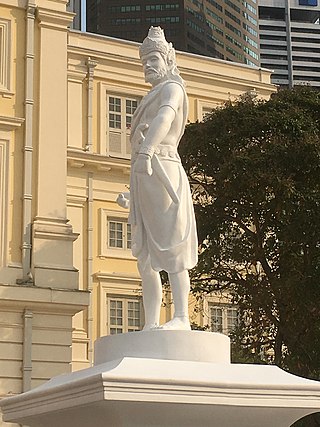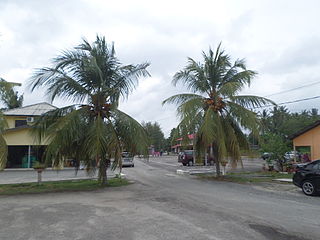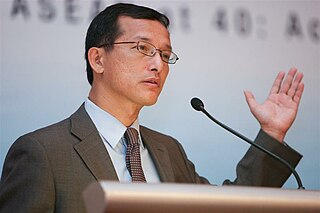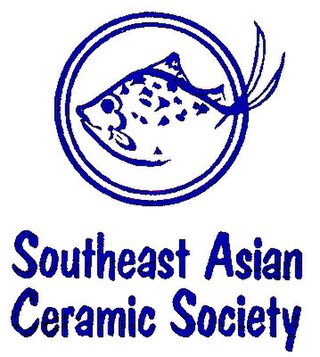Related Research Articles

The Sa Huỳnh culture was a culture in modern-day central and southern Vietnam that flourished between 1000 BC and 200 AD. Archaeological sites from the culture have been discovered from the Mekong Delta to Quảng Bình province in central Vietnam. The Sa Huynh people were most likely the predecessors of the Cham people, an Austronesian-speaking people and the founders of the kingdom of Champa.

Vietnamese ceramics refers to ceramic art and pottery as a form of Vietnamese art and industry. Vietnamese pottery and ceramics has a long history spanning back to thousands of years ago, including long before Chinese domination, as archeological evidence supports.

Sang Nila Utama was a Srivijayan prince from Palembang and is the founder of the Kingdom of Singapura in 1299. His official title adopted upon his coronation was Sri Tri Buana, which can be translated as "Lord of Three Worlds"; the "Three Worlds" may refer to the three realms of the universe—the heaven of the gods, the world of humans, and the underworld of demons or his lordship over Java, Sumatra and Temasek/Singapura. This title is attested to elsewhere in Southeast Asia.
Archaeology in Singapore is a niche but growing discipline. Although there is generally a lack of government support for archeological work, many artifacts have been unearthed at sites around the island, helping to give a clearer picture of Singapore's history, both concerning the early history of Singapore and its subsequent colonial settlement following the founding of modern Singapore, the former being particularly useful in revealing archaeological evidence reflecting references to settlements such as Temasek, Ban Zu, Long Ya Men and the Kingdom of Singapura in chronicles and records.

Johor Lama is a mukim in Kota Tinggi District, Johor, Malaysia. It is situated on the banks of Johor River. It was once a thriving port and the old capital of the Johor Sultanate.

The early history of Singapore refers to its pre-colonial era before 1819, when the British East India Company led by Stamford Raffles established a trading settlement on the island and set in motion the history of modern Singapore.

Paṭṭiṉappālai is a Tamil poem in the ancient Sangam literature. It contains 301 lines, of which 296 lines are about the port city of Kaveripoompattinam, the early Chola kingdom and the Chola king Karikalan. The remaining 5 lines are on the proposed separation by a man who wants to move there and the separation pain of his wife who would miss her husband's love. Of the 301 lines, 153 are in the vanci meter and the rest are in akaval. It is sometimes referred to as Vancinetumpattu, or the "long song in the vanci meter". The poem was composed by Katiyalur Uruttirankannanar, sometime around 1st century and 2nd century CE, states Kamil Zvelebil – a Tamil literature scholar.
Cổ Loa Citadel is an important fortified settlement and archaeological site in present-day Hanoi's Đông Anh district, roughly 17 kilometers north of present-day Hanoi, in the upper plain north of the Red River. Various relics of the Bronze Age Phùng Nguyên culture and Đông Sơn culture have been found in Cổ Loa, although it was later established as the capital of Âu Lạc Kingdom during the 3rd century BCE. It might be the first political center of the Vietnamese civilization. The settlement’s concentric walls resemble a snail’s shell; it had an outer embankment covering 600 hectares.

This is a timeline of Indonesian history, comprising important legal and territorial changes and political events in Indonesia and its predecessor states. To read about the background to these events, see History of Indonesia. See also the list of presidents of Indonesia.

Louis Finot was a French archeologist and researcher, specialising in the cultures of Southeast Asia. A former director of the Ecole française d'Extrême-Orient, his contribution to the study of Khmer history, architecture and epigraphy is widely recognised.

Simon Tay Seong Chee is a Singaporean lawyer and legal academic who served as a Nominated Member of Parliament between 1997 and 2003.
Aung Thaw is a Burmese archaeologist and Emeritus Director-General of the Archaeological Survey of Burma.

Tutuala is a village and suco in the subdistrict of Tutuala. It is situated at the extreme eastern end of Timor. Its population at the 2004 census was 3,707. The subdistrict of Tutuala comprises two sucos, including Mehara and Tutuala with the subdistrict administrator residing in Tutuala. The suco of Tutuala comprised four hamlets (aldeia): Ioro, Pitileti, Tchailoro, and Vero. The main Fataluku language areas of the country are in Tutuala, as well as Lautem and Fuiloro.

The Buni culture is a prehistoric clay pottery culture that flourished in coastal northern West Java, Jakarta and Banten around 400 BC to 100 AD and probably survived until 500 AD. The culture was named after its first discovered archaeological site, Buni village in Babelan, Bekasi, east of Jakarta.

Barus is a town and kecamatan (district) in Central Tapanuli Regency, North Sumatra Province, Sumatra, Indonesia. Historically, Barus was well known as a port town or kingdom on the western coast of Sumatra where it was a regional trade center from around the 7th or earlier until the 17th century. It was also known by other names, namely Fansur and possibly Barusai. The name Fansur or Pansur means "spring of water" or "a place where water flows" in the local Malay language/Batak language. Barus was well known for its produce camphor. In the 16th century, Barus came under attack from the rising power of Aceh, and became absorbed into the Aceh Sultanate. The earliest known Malay poet Hamzah Fansuri may be from Barus as indicated by his name.

Ban Zu or Banzu was a port settlement believed to have thrived in Singapore during the 14th century. It is thought to be located on Fort Canning Hill and the area on the north bank of the Singapore River basin between the hill and the sea. It was mentioned by the Chinese traveller Wang Dayuan in his work Daoyi Zhilüe together with Long Ya Men as the two settlements that made up Temasek. It may have been abandoned before 1400 after an attack by either the Siamese or the Majapahit.
Sri Maravijayottunggavarman was a king of Srivijaya Kingdom of Shailendra dynasty, who reigned between 1008-c.1025 CE. He was the son of King Sri Chudamanivarmadeva. He was called Se-li-ma-la-pi in the Chinese chronicle.

The Southeast Asian Ceramic Society (SEACS) was founded in 1969 in Singapore. It is a member of the London-based Oriental Ceramic Society.
This is a timeline of the history of the Kingdom of Champa and its people–the Cham–an Austronesian-speaking ethnic group in Southeast Asia.

Quduqian was the Chinese designation for an ancient kingdom, chiefdom, or a polity that perhaps located around Binh Dinh province, Central Vietnam, then became part of Champa Kingdoms.
References
- ↑ Tng Ying Hui, Not Born in Singapore: Fifty Personalities Who Shaped the Nation, Singapore: Epigram Books, 2019, p. 143
- ↑ Kibaroğlu, Dr Onat (2016-01-01). "Academic Review of John Miksic: A Journey from the Frigid Lands of the United States to the Archeological Grounds of Northern Sumatra and Beyond".
{{cite journal}}: Cite journal requires|journal=(help) - ↑ Flipsnack. "Wreckwatch Magazine - Autumn 2021". Flipsnack. Retrieved 2022-10-07.
- ↑ Justin McDaniel, "A Review of the Historical Dictionary of Southeast Asia" in Journal of the American Oriental Society, Vol. 128, No. 2 (Apr–Jun 2008), pp. 342–44.
- ↑ Tng Ying Hui, Not Born in Singapore: Fifty Personalities Who Shaped the Nation, Singapore: Epigram Books, 2019, p. 145.
- ↑ pbjwelch (2022-05-03). "Past & Present SEACS Presidents". Southeast Asian Ceramic Society (SEACS). Retrieved 2022-10-25.
- ↑ Tng, Ying Hui (2015). Not born in Singapore : fifty personalities who shaped the nation (First ed.). Singapore. p. 148. ISBN 978-981-4655-41-5. OCLC 932118466.
- ↑ Melody Zaccheus, "Indian Jones who Pieces together S'pore's Past", in The Straits Times 11 November 2013, p. 4.
- ↑ Chandrashekhar, Vaishnavi (2017). "THE LION CITY'S GLORIOUS PAST". Archaeology. 70 (6): 61–68. ISSN 0003-8113.
- ↑ C. M. Turnbull, "Early Singapore 1330s–1819 in Journal of the Malaysian Branch of the Royal Asiatic Society, Vol. 78, No. 1 (288) (2005), pp. 122–124.
- ↑ Asad Latif, "Pre-Raffles Singapore:A Thriving Port," The Straits Times, 9 November 2013, p. 19.
- ↑ Peterson, Jane A. (2014-05-11). "In New Textbook, the Story of Singapore Begins 500 Years Earlier". The New York Times. ISSN 0362-4331 . Retrieved 2022-10-07.
- ↑ Auto, Hermes (2018-01-11). "Archaeologist wins inaugural Singapore history prize | The Straits Times". www.straitstimes.com. Retrieved 2022-10-07.